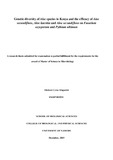| dc.description.abstract | Aloe species are common in Kenya and have many health benefits which include promotion
of wound healing, antifungal activity, hypoglycemic or anti-diabetic effects, antiinflammatory
and anticancer properties. However, little has been done to study the genetic
variability of Aloe species in Kenya. Fusarium oxysporum and Pythium ultimum are
economically important plant pathogens with a wide host range causing several diseases
including root rots and damping off. The objectives of this study were to genetically
characterize Aloe species found in Kenya and assess the efficacy of their extracts on
Fusarium oxysporum and Pythium ultimum. Thirty one morphologically diverse Aloe species
were sampled from ex-situ and in-situ collections. Morphological characterization was done
using leaf color, presence or absence of variegation and color of spines. DNA extraction was
carried out using cetyl trimethyl ammonium bromide (CTAB) method. Sequence related
amplified polymorphism (SRAP) markers were used to determine genetic diversity of the
Aloe species Forty eight primer pairs were screened to select those that had the highest
number of polymorphisms. Eight primer pairs, which were polymorphic, were selected to
genotype the Aloe species. Crude extracts of the leafs were made by extracting with
dichloromethane: methanol in the ratio of 1:1 and made into concentrations of 100mg/100μl,
50mg/100μl, 25mg/100μl, 12.5mg/100μl and 6.25mg/100μl using sterile distilled water.
Similar concentrations were done with the antifungal drug triazole as the positive control.
Assessment of the efficacy of different concentrations of the Aloe species leaf extracts against
Fusarium oxysporum and Pythium ultimum was carried out using the agar disc diffusion
method. Paper discs impregnated with different concentrations of the Aloe extracts were
placed in the petri plates and zones of inhibition measured in millimeters for 11 days. SRAP
primers produced 893 genetic loci with percentage polymorphic loci of 56.8%. Nei genetic
distance for the populations ranged from 0.094 to 0.362 with 9% and 91% variation among
xiv
populations and within individuals, respectively. Organic crude extracts of A. Secundiflora
showed the highest activity (Mean inhibition = 16.01 mm) against the test fungi compared to
A. lateritia (Mean inhibition = 13.09 mm) and A. turkanensis (Mean inhibition = 11.04 mm).
The crude extracts showed higher activity against F. oxysporum than P. ultimum; but there
was no activity for all the crude extracts at 6.25mg/ml. None of the crude extracts showed
higher activity than the commercially used fungicide triazole. The findings of this study could
form basis for better conservation of the genus which has potential to control fungi of
agricultural importance alongside other control measures.
Key words: Aloe species, Sequence Related Amplified Polymorphism (SRAP), Fusarium
oxysporum, Pythium ultimum. | en_US |



